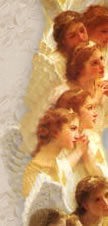




 |
|

|
|
|||||||||||
|
|
|
|
||||||||||||
 |
|
|
||||||||||||
 |
|
 |
|
|||||||||||
|
|
||||||||||||||
 |
 |
|
|
|
|
The New Rite of Exorcism In his famous discourse of June 30, 1972, Pope Paul VI said that he sensed “that from somewhere or other, the smoke of Satan has entered the temple of God.” Nowhere has this been more evident than in the disastrous revision of the blessings of the Church in De Benedictionibus, the so-called “Book of Blessings,”1 approved in 1984. In the original Latin this defective book scandalously refuses to bless objects, but only persons. The example of Christ our Lord in blessing things (e.g., Matt. 14:19; 26:26; Mk. 6:41; 8:7; 14:22; Lk. 9:16; 24:30) obviously carried no weight with the liturgists who wrote that book. The official General Introduction to the Book of Blessings informs us: “At times the Church also blesses objects and places connected with human activity or liturgical life, or connected with piety and devotion – but always, however, with a view to the people who use those objects and are engaged in those places” (Praenotanda Generalia, 12). This explanation is dishonest, in that it gives only half a reason for blessing things, and because it conceals the fact that the book of blessings, with a few exceptions, systematically refuses to bless things. It is a book of non-blessings. To take but one example, the “blessing” of holy water outside of Mass contains no actual blessing of the water. The closest thing to it is a prayer to God asking for certain effects by the use of this water. The so-called “Prayer of blessing” (in Latin and English) refrains from using the word “bless” even once, and there is no Sign of the Cross made over the water. The Devil must have laughed when that “Book of Blessings” was issued. The traditional exorcism of water and salt, and all the other Roman Ritual’s traditional prayers against the devil and his influence were almost completely abolished. On three occasions only is a thing blessed. These three exceptions in Latin are for meals, church bells and cemeteries. In the American edition, the same things appear; also chalice and paten (found in Latin in the Pontifical); also two other places in which the alternative rite (not in the Latin) does bless an object.2 (The blessing of holy water within Mass does contain an actual blessing of the water.) The treatment of blessings in the Catechism (#1671-2) speaks of blessings of persons, places and things. But this is belied, as I have said, by the Latin text of De Benedictionibus, the “Book of Blessings,” so called. When the definitive Latin text of the Catechism was issued in 1997, with the paragraph saying that the Church blesses things, a priest friend wrote to Cardinal Ratzinger pointing out that the lex orandi and the lex credendi were at odds, and asked a question: “Can we expect a revision of the Book of Blessings in the light of the definitive text of the Catechism?” Of course, this is a reversal of the traditional practice and view of things: one is meant to pass from the Church’s practice to a formulation of the Church’s faith. But, if it will do good, the reversal has become a necessity. What lies behind this change to the rites of blessings? Clearly, a loss of sense of the power of the priesthood – a desire, even, to overthrow sacerdotal mediation, to reduce the priest from an instrument of Christ, clothed with the authority of Jesus Christ, to a mere prayer, on the same level as that of any lay person. The retention of the title “Blessings” means nothing: as we know, All Souls’ Day is No Souls’ Day, even in the original Latin, where the word for soul (anima) has been suppressed in the prayers of November 2.3 The New Rite of
Exorcism Let us read that definition again, with emphases added: “When the Church asks publicly and authoritatively in the name of Jesus Christ that a person or object be protected against the power of the Evil One and withdrawn from his dominion, it is called exorcism.” Notice the use of the word asks, and the use of the passive voice. The text says that the Church asks for this person or object to be protected. Asks whom? For protection by whom? Obviously, God. So, according to this, an exorcism is: asking God to free someone from the devil. But, despite what this text implies, an exorcism is not a prayer to God; exorcism is a command issued to the Devil in the name of God. The very word exorcism tells you that – exorcizo, I adjure. To adjure, as the Oxford Dictionary defines it, is to charge or entreat someone solemnly, as if under oath, or under the penalty of a curse. No one can adjure God, but a minister of God can adjure a demon. The Ritual for Exorcism of 1614 (which until January 1999 was the only officially published text for Latin rite exorcists) does contain prefatory prayers to God to ask that a person be delivered – but then under the subheading of “Exorcism” itself, the exorcist orders the demon to depart. “Exorcizo te, immundissime spiritus…in nomine Domini nostri Jesu Christi” – “I exorcize you, unclean spirit…in the name of our Lord Jesus Christ.” He uses other imperatives addressed to the demon, such as recede, da locum, exi, discede (withdraw, give way, exit, depart). The new ritual scandalously gives the priest a choice of two forms of exorcism, which it calls “deprecatory” and “imperative.” “Deprecatory” means a prayer to God, in this case to ask Him to deliver the demoniac. “Imperative” means a command issued to the demon in the name of God to depart. The imperative formula is a real exorcism, but the deprecatory form is not an exorcism at all. A prayer is a request to God; an exorcism is a command to a demon. The so-called “deprecatory exorcism” is simply a petitionary prayer to God. It is not an exorcism. (If it is an exorcism, then the final petition of the Lord’s Prayer, “deliver us from evil,” would also be an exorcism!) As with the so-called “exorcism” in the modern Rite of Baptism, simply placing the sub-heading Exorcism does not make what follows an exorcism. What is extremely worrying is that, according to the new rubrics, the deprecatory form must always be used, but the second form, the imperative, is an optional extra. What lies behind this change? The same denigration of the priesthood described above. It is a true Protestantization: the reduction of the ordained priest to the level of the common priesthood. It is the fruit of embarrassment about the visible priesthood. It is the mentality that is at work when a priest says at the end of Mass: “May Almighty God bless us….” When a priest does that, he is losing his identity, and is uncomfortable about the fact that he is different, and that he can confer blessings. Here is an extract from one of the new deprecatory formulas:
As we can see, this is merely a petitionary prayer. Here is an extract from one of the new imperative formulas:
As one can see, this optional formula is an exorcism proper. In the former rite, there were prayers to God asking for deliverance, but they were always followed by exorcisms proper. Changes to the Old
Directives to the Exorcist 4. In order to better test these signs [of possession], the priest should question the demoniac after one or other exorcism as to what he feels in his mind or body, so that in this way he can also learn which words more greatly disturb the demons, so as then to bear down on them and repeat them all the more. 5. The priest should stay alert for tricks and deceptions that demons use to mislead the exorcist. For they will give false answers as much as possible, and show themselves only with difficulty, in order that the exorcist at length become worn out and give up the exorcism; or the ill person might appear not to be harassed by the devil. 6. Occasionally, after they appear, the demons hide and leave the body almost free of all disturbance, so that the ill person might think he is completely freed. But the exorcist should not stop until he sees the signs of liberation. 8. Some demons point out an act of witchcraft which has been done [to cause possession], by whom it was done, and the way to undo it; but the demoniac should be careful not to have recourse to sorcerers, fortune-tellers, or other such persons, on this account, but should go to the ministers of the Church rather than use any superstitious or otherwise illicit means. 9. Sometimes the devil grants the sick person relief and permits him to receive the Holy Eucharist so that he might seem to have departed. In short, there are countless devices and tricks of the devil to deceive man, which the exorcist should beware, lest he be deceived. 13. …Also relics of Saints, where available, safely and properly fastened and covered, may be reverently applied to the chest or head of the possessed. Care must be taken that the sacred objects are not improperly handled or harmed in any way by the demon. Because of danger of irreverence, the Holy Eucharist should not be placed upon the head of the possessed person or elsewhere on his body. 14. The exorcist should not engage in a great deal of talking or ask unnecessary or curious questions, especially concerning future or secret matters not pertaining to his task. But he should command the unclean spirit to be silent, except to answer his questions. Nor should he believe the demon if he pretends to be the soul of some Saint or deceased person or a good Angel. 15. However, there are necessary questions, for example, concerning the number and names of the possessing spirits, the time and reason they entered, and other things of this sort. The exorcist should restrain or spurn the rest of the devil’s nonsense, laughter and foolishness, and advise those present, who should be few, that they must not pay attention to these things nor question the possessed person, but rather humbly and earnestly pray to God for him. 16. The exorcist should read and carry out the exorcism with strength, authority, great faith, humility and fervor, and when he sees that the spirit is especially tormented, then he should persist and bear down all the more. And whenever he sees that the possessed person is being disturbed in some part of his body, or stung, or that a swelling appears somewhere, he should make the sign of the cross on that area and sprinkle it with holy water which should be on hand. 17. He is also to observe at which words the demons tremble more, and then he should repeat these words more often. When he reaches the threatening words, he should say them repeatedly, always increasing the punishment. If he sees that he is making progress, he should continue for two, three, or four hours, or even longer if he can, until he obtains the victory. 19. If he is exorcising a woman, he should always have persons of integrity with him to hold the possessed person while she is agitated by the demon. These people should be close relatives of the suffering woman if possible. Mindful of decency, the exorcist should be careful not to say or do anything which could be an occasion of an evil thought to himself or the others. 20. While he is exorcising, he should use the words of Sacred Scripture rather than his own or someone else’s. He should command the demon to tell him if he is held in that body because of some magic, or sorcerer’s signs or devices. If the possessed person has consumed things of this sort orally, he should vomit them up. If they are elsewhere outside his body, he should reveal where they are, and once found, they are to be burned. The possessed person should also be advised to make known all his temptations to the exorcist. These crucial directives, followed by exorcists for 385 years, have no parallel in the new introduction. The preface explicitly says that lay people may not say any of the prayers of exorcism, and repeats the old directive that exorcism is not to be conducted in public. It adds the rule (a welcome addition) that exorcism is not to be open to any communications media; and the exorcist and any assistants are not to speak publicly before or after the exorcism about what took place. Other Changes Laughable, however, are the references, in the prefatory decree, to Sacrosanctum Concilium of Vatican II – as if the Council had called for a revised, updated exorcism to allow full conscious participation by the laity! The only conceivable allusion to exorcism in the Vatican II decree on the liturgy is where it says the sacramentals will be revised – but the clear proof that the bishops never had exorcism in mind is seen from the reason given for revision. The one and only relevant sentence here says: “The sacramentals are to be revised, account being taken of the primary principle of the intelligent, actual and easy participation of the faithful” (art. 79). Since exorcism, new and old, must be conducted away from the faithful, the principle of intelligent, actual and easy participation is irrelevant. Once again, the liturgical decree is cited as the basis for something never intended. Dishonest is the use of the word instauratum (restored) in the subheading of the title page: the new exorcism ritual is in no way a restoration. It is a fabrication. The Latin should have read fabricatum or innovatum or maybe concoctum! The preface provides for translation of the rite into myriad languages – but what on earth for? If an exorcist does not know enough Latin to perform the prayers in Latin, he should not be appointed to the office. The preface at no. 13 quotes canon 1172 saying that an exorcist should be, inter alia, “outstanding in knowledge” – but how could that be said of a priest who cannot say or follow very simple texts and prayers in Latin? As well, given charismatics’ predilection for exorcisms and “deliverance,” it is highly imprudent to make the Church’s official exorcism prayers available to all and sundry in every language, when only a tiny proportion of priests need to use them. With the promulgation of the new exorcism ritual, the Athanasian Creed has now officially disappeared from any Catholic ritual. In the 1960s, its frequency was reduced in the Breviary and finally it was abolished from it. The rite of exorcism was the last surviving ceremony in the Church where the Athanasian Creed was recited. Now it is gone. This is a serious loss, and there was no good reason why it was replaced by a choice between the Apostles’ Creed and the Nicene Creed. Another innovation, but a welcome one, in the new Ritual for Exorcism, is an exorcism to be used for a place or thing, something not specifically present in the former Ritual. (Herbert Thurston S.J.’s book Ghosts and Poltergeists5 has an appendix containing his English translation of an “Exorcism of a house troubled by an evil spirit,” which he found in the Appendix of an edition of the Roman Ritual printed in Madrid in 1631, published with the authorization of the Inquisition. Father Thurston evidently thought this was a worthwhile ceremony to have.) This new rite for a place or thing also requires permission from the bishop before being used. Again, however, in this ceremony, the imperative formula, the true exorcism, is to be added, only if the priest wishes. Conclusion According to the president of the International Association of Exorcists, Father Gabriele Amorth (30 Days, no. 6, 2001), when the new rite was ready, Cardinals Ratzinger and Medina sought to add a provision in its introduction authorizing the use of the previous rite. This move of theirs was rejected, so Cardinal Medina issued a separate notification that an exorcist can use the old rite if his bishop asks the Congregation for Divine Worship, who will “gladly provide the requested permission” (Notitiae, vol. 35, 1999). The new rite will one day itself be subject to a true restoration, which will restore to the obligatory texts of the exorcist the true nature of his office.
Notes 2 Meals, church bells and cemeteries: pp.300-318, 400, 429. In the American edition, same things at pp. 439-458, 565, 609; also p.589 for chalice and paten (found in Latin in the Pontifical); also p.624 (article of devotion) and p.634 (rosary) where the alternative rite (not in the Latin) does bless an object. 3 The word anima is suppressed in all of the funerals and Masses for the dead, except one: two of the proper prayers in the Mass, “Pro defunctis fratribus, propinquis et benefactoribus,” Missale Romanum 1975, pp.909-10. 4 Full title page reads: RITUALE ROMANUM EX DECRETO SACROSANCTI ŒCUMENICI CONCILII VATICANI II INSTAURATUM AUCTORITATE IOANNIS PAULI PP. II PROMULGATUM DE EXORCISMIS ET SUPPLICATIONIBUS QUIBUSDAM EDITIO TYPICA, TYPIS VATICANIS, MIM. It has not yet appeared in English. 5 Edited after his death by Fr Crehan S.J. and reprinted in 1998 by Roman Catholic Books, USA. . |
|



♦ About The Mass ♦ Resources ♦ How To Help ♦ Contact Us ♦